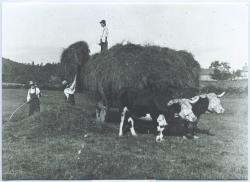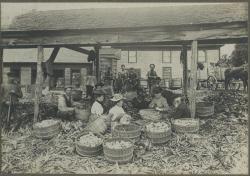Cultivating the Land
While colorful, logging has not been the only significant form of land use in Maine history. Maine is not noted for its fertile farmland, but farming and gardening have been enduring elements of the Maine survival strategy.

Herb catalog, United Society of Shakers, New Gloucester, 1864
United Society of Shakers
Lura Beam's charming story of her childhood in Down East Maine at the turn of the 20th century depicts her grandparents' "market gardening" as "an artistic and scientific occupation," an enterprise that offered social and aesthetic value for the consumers, as well as satisfaction for the producers.
Midwife Martha Ballard, who lived in the Hallowell area at the end of the 18th century, regularly recorded details about her vegetable gardens, fields, and medicinal herbs in her journals. Entries such as "Planted squash, Cucumbers, musk and water melons East side house" punctuated her diary and her life along with those of a larger scale, such as "Son Jonathan ploughing our field."
The Shakers of Sabbathday Lake, Alfred, and Gorham, like those everywhere, kept detailed records of crops, herbs, fruits and vegetables planted, harvested, and preserved. Although these accounts entailed widely different scales and purposes, all recognized gardening as necessary, significant, and even gratifying work.
Food, whether found, hunted, husbanded, or cultivated, is both primal and profoundly social. It is imbedded in communal celebrations and public rituals. It represents some of the earliest political and economic activities of humankind. Its management and storage provided the context within which large-scale social stratification could occur, and what is known popularly as civilization could emerge.
Traveling seasonally like much of the people of the eastern forests, Wabanaki peoples had taken advantage of the area's bounty summering near rivers and coasts for their fish and shellfish, and moving inland where they could hunt for the winter for countless generations.

Haying, Baldwin, ca. 1890
Baldwin Historical Society
They also enjoyed a range of roots, nuts, seeds, fruits, berries, and animals at various times of the year, organized hunts, cultivated maize, as well as varieties of squash and other vegetables, and preserved food for anticipated lean times.
European colonists, who usually brought their own species of animal and vegetable varieties, preferred situating themselves in small riverine or coastal settlements and cultivated land for personal rather than communal use.
Competing concepts regarding land ownership and use often led to bitter conflicts between natives and newcomers, and colonial agrarian settlements, while generally self-sufficient, expanded fitfully.
Maine's relatively remote location, uneven soils, and short growing season, make commercial agriculture a challenge. Even so, Maine settlers were shipping marsh hay to the Boston area in the 18th century, and colonial neighbors regularly traded or sold surplus produce in localized markets, and raised crops to feed themselves, their neighbors and their livestock.

E. S. Dingley Corn Shop crew and huskers, Farmington Falls, ca. 1900
Farmington Historical Society
Maine's long practice of diversified subsistence agriculture gradually shifted in the 19th century as it consolidated, specialized and modernized in response to regional and national markets.
Sometime in the mid 19th century wild blueberries were converted to marketable commercial crops, being shipped to Boston and beyond. Soon, canneries sprang up, increasing the market for the crop.
Likewise, once canning became practical at the end of the 19th century, Mainers took to it with gusto as a means of marketing their vegetable crops. More than 100 canneries operated in the state, many specializing in corn. But entrepreneurial farmers and canning factories canned other vegetables farmers grew in large quantity.
As railroads penetrated further north late in the century, Aroostook County's loamy soil proved suitable for commercial potato farming. Maine potatoes have been widely marketed, used for starch, and sold for processing into French fries. While the potato has declined in production and economic importance in the last few decades, it remains a staple of Maine agriculture.
Relatively small dairy farms have been found in all parts of the state since early settlement. The Maine Agricultural Society, organized in the first decades of the 19th century, and its successors sponsored agricultural shows so farmers could learn about different breeds of dairy cows and new farming techniques.

Transporting milk, North Yarmouth, ca. 1915
North Yarmouth Historical Society
Family dairy farms in Maine, as in much of the country, are increasingly threatened by economic circumstances and regulatory realities.
The back-to-the-land movement of the 1970s brought a new kind of settler to Maine and spurred some existing agricultural operations to diversify. Having created a bona fide industry, Maine's organic and small-scale farmers repudiate the mechanized commodity agriculture that has played havoc with so many small and family farms elsewhere, and embrace the emerging ethic of "local agriculture."
From farmers' markets to a notable presence in supermarket produce aisles, these farmers are having some success. While they alone might be insufficient to buoy a flagging agricultural economy, they are proving economic and ecological sustainability can be compatible practices, and demonstrating again the adaptability of Maine's people.










